Protecting & Restoring Long Island's Peconic Bays
By Kaitlin Morris
In addition to monitoring horseshoe crabs in the middle of the night (see my other blog post), I also monitored nesting diamondback terrapins during the day! The diamondback terrapin (Malaclemys terrapin) is easily distinguished by the diamond-shaped, concentric rings on its shell.
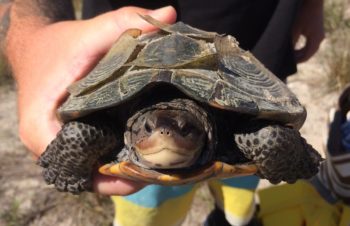
This turtle species spends its entire lifecycle in the brackish (where salt and fresh water mix) protected estuarine waters along the East Coast of the United States and is found nowhere else in the world! Terrapins are the only brackish North American turtle, and the only turtle native to Long Island’s salt marshes, or Spartina marshes. The turtles use this salt marsh habitat for finding food and as a nesting and nursery ground for their babies.
Sadly, diamondback terrapin populations are declining. Urbanization, pollution, predators, and accidental capture in fishing gear are all taking their toll on the species, making it so important to monitor their population. Monitoring efforts by PEP and other organizations help scientists observe population trends and can eventually help conserve the species and its habitat.
Peconic Estuary Program began a pilot monitoring program in 2017 to determine where diamondback terrapins are nesting on the East End of Long Island. As a terrapin monitoring intern in this program’s second year, my role was to monitor Northwest Harbor County Park in East Hampton for evidence of terrapin nesting activity during their nesting season from June through early August. To keep data consistent, the other intern, Noah, and I patrolled at high tide depending on the cycle of the moon. Each first quarter, full moon, third quarter, and new moon, we met at high tide three times per week to look for terrapin tracks, test holes, predated nests, and live turtles.
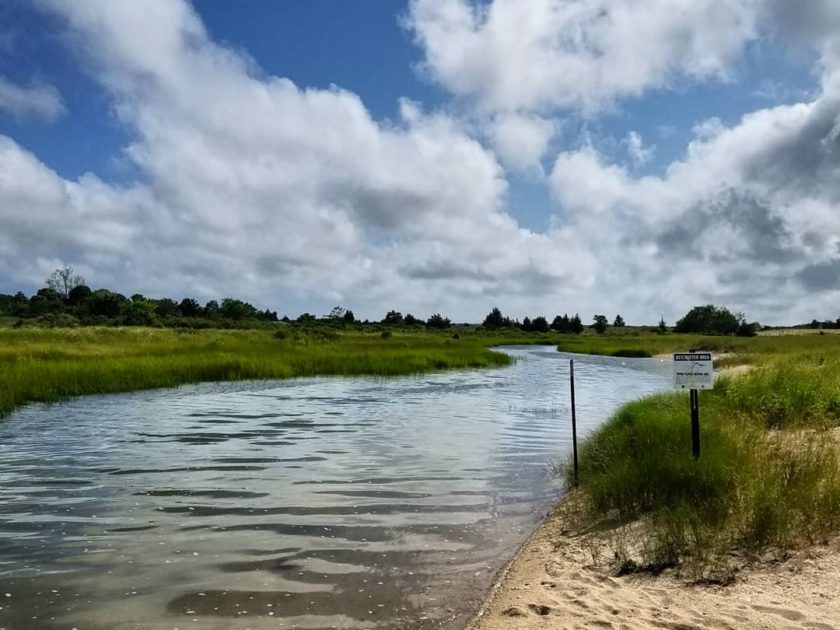
Terrapin tracks have a distinct look because the female terrapin carries her body using her strong back legs to pull her shell along the sand, creating a smooth indent where the shell drags between her footprints. A test hole or test nest is where a female began to dig a nest, but chose not to lay her eggs in that location, leaving a deep, round hole in the ground. At first, it was hard to tell the difference between different holes we found at the monitoring site. It’s hard to know what to look for until you get a little more practice! However, after finding a few, it became easy to distinguish the test holes from other indents in the sand. Predated nests are nests where the female terrapin successfully laid her eggs, but they were unfortunately eaten by predators such as raccoons before hatching. These were easy to recognize due to the shredded egg shells surrounding the nest.
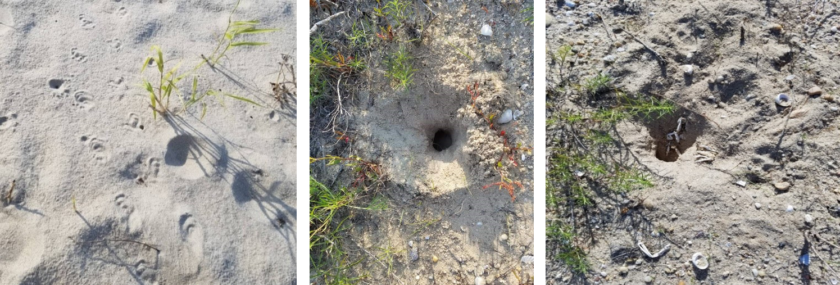
If nesting female turtles were found, Noah and I measured the length and width of her carapace (the top portion of a turtle’s shell), placed her on a vinyl bag and used a luggage scale to weigh her. Some of the terrapins didn’t seem to mind, while others hid inside their shells or stretched out their necks to try and snap at us.
To determine whether or not a female turtle had already nested, we were trained to feel the sides of her body beneath her shell for eggs. If we could feel eggs inside, we painted a small dot on her carapace using nail polish to easily identify her in case we saw her again. If she had already nested and no longer contained eggs, it was safe to inject a PIT tag, as instructed by Dr. Russel Burke, the leader of Jamaica Bay Wildlife Refuge Terrapin Research Project.
This tag, similar to an I.D. chip commonly used in dogs and cats in case they are lost, is a harmless, tiny pin that identifies each animal by a number that is scanned with a PIT tag reader. Tagging each female terrapin after she nests will allow PEP to identify any recaptured terrapins in following years as well as improve population monitoring in the long run. Since this is the first year that PIT tagging was included in the pilot monitoring program, PEP has to conduct PIT tagging for a few more years to see any trends in terrapin nesting behavior. Implanting these tags will help us estimate the number of individual nesting female terrapins in the population, gather data on nesting behavior, and encourage improved conservation efforts.
Although Noah and I found lots of nests, test holes, and tracks, finding live female terrapins was much less common.
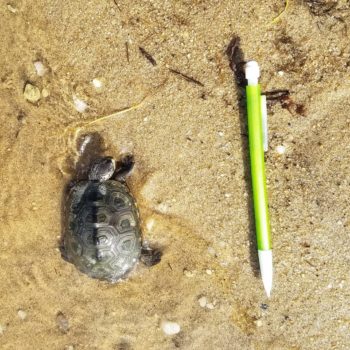
Throughout the entire nesting season, we found only 5 nesting terrapins. However, we did come across a baby terrapin at the edge of the water which was a great moment to experience! Even though we didn’t find many live terrapins, the fact that we discovered plenty of terrapin evidence tells us that this site is favored as a nesting habitat. Tracks, test holes, and predated nests all matter when it comes to terrapin monitoring because they show that terrapins are nesting in the salt marshes of the Peconic Estuary. PEP’s monitoring program and the data it provides will help to influence future conservation decisions to help protect diamondback terrapins and their habitat.
Northwest Harbor County Park was a beautiful place, so Noah and I both enjoyed the chance to get outside and do hands-on work in such a gorgeous environment. As an aspiring marine conservation scientist, what more could I ask for than to be working in nature looking for turtles?
We also enjoyed leading a citizen science volunteer monitoring day in late July. After a few months of monitoring terrapins on our own, we loved the opportunity to lead a group of volunteers through the process and explain what we’re looking for and why. Having fresh eyes was also very helpful to the monitoring efforts—several new predated nests were spotted that day, especially by the youngest volunteers!
My diamondback terrapin monitoring internship with Peconic Estuary Program was an amazing opportunity to gain experience in a variety of projects while immersing myself in hands-on field work and outreach. Even better, with this internship I felt like I was actually making a difference for science and wildlife conservation on Long Island. Now, as an employee of Cornell Cooperative Extension and PEP, I am even more grateful to have had this real world experience!
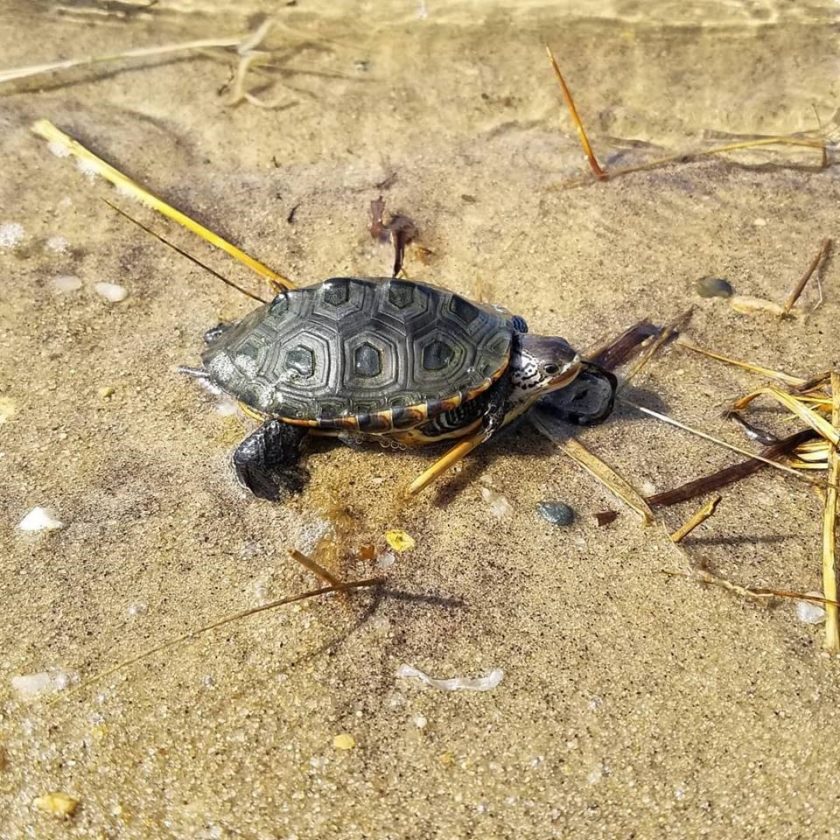
Sign up for News, Events and Information straight to your inbox.
